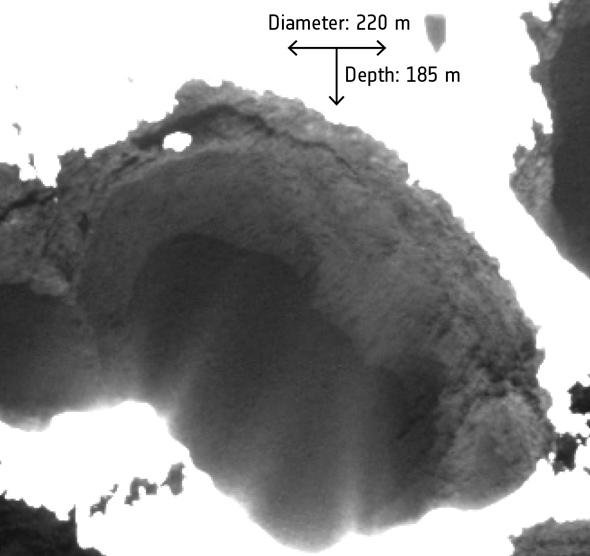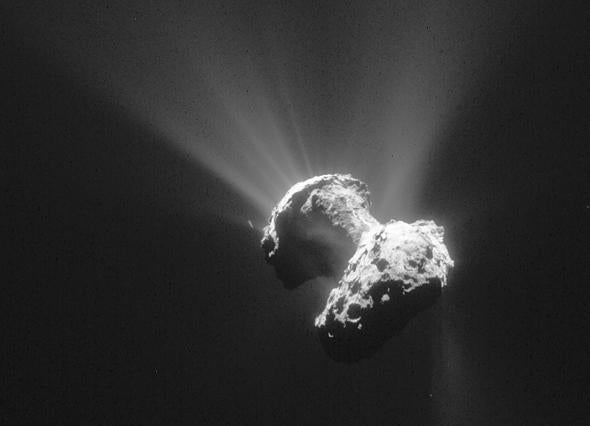“No, no. We have already succeeded. I mean, what are the terrors of the Comet? One, the ice venting—no problem. There’s a popping sound preceding each; we can avoid that. Two, the sinkhole, which you were clever enough to discover what that looks like, so in the future we can avoid that too.”
—The Dread Astronomer Westley Roberts
The comet 67P/Churyumov-Gerasimenko is heading toward the Sun, and as it does, it slowly dies.
But what a death. Underneath its crusty surface are icy deposits, and as the comet nears the Sun, these warm. The ice turns directly to gas and blows out of vents, forming gorgeous and delicate streamers of water vapor dozens of kilometers long. The picture at the top of the article shows the long-distance view of this; from 177 kilometers away, the Rosetta spacecraft sees quite a few of these jets.
But what do these do to the surface? Some of the vents have been seen in close-up views from Rosetta, and they come from pits that you might mistake for impact craters at first. It’s clear these are the sources of at least some of the jets, but a new study reveals they’re more than that: They’re sinkholes.

Photo by ESA/Rosetta/MPS for OSIRIS Team MPS/UPD/LAM/IAA/SSO/INTA/UPM/DASP/IDA; graphic from J-B Vincent et al (2015)
Sinkholes on Earth are relatively common; water (for example) can erode away material under the surface, and at some point gravity takes over, and the structural integrity gives way. The surface collapses, sometimes taking cars or even houses with it.
On a comet things are slightly different. For one, the gravity is only a tiny fraction of Earth’s. For another, sinkholes on Earth tend not to jet towers of water vapor out from them.
But the overall idea is the same. Heat from the Sun warms the comet. This heat leaks under the surface (possibly through cracks) and turns the ice into gas, which then leaks out. Eventually a large cavity is formed under the surface, so big that the “roof” of material over it collapses, forming the steep-walled sinkholes.
This allows light to flood in, which can heat the ice rapidly, causing an outburst of jetting from the comet. This has been seen on 67P, too. Eventually, the walls of the hole erode as more ice vaporizes, and the steep pits become more shallow. Quite a few of these are seen on 67P as well. This means the steep pits are young, and the shallow ones old.
While this result doesn’t surprise me—it’s been suspected since the first close-up pictures came back from Rosetta—it’s nice to see the whole story figured out, and an explanation found for the steep pits.
Comets are so cool. And this one has turned out to be a fantastic choice for an extended visit by Rosetta. We’re learning so much about these interplanetary wanderers, and, unsurprisingly, it’s all been really amazing.
